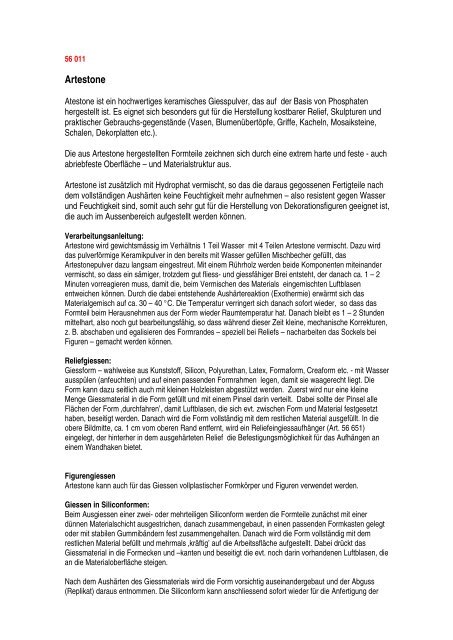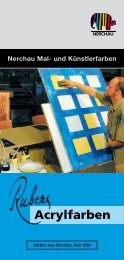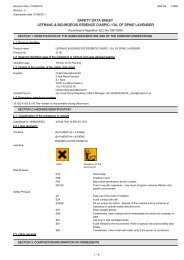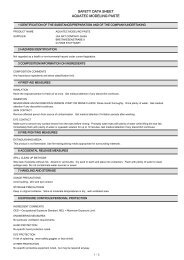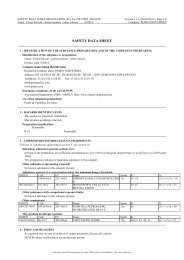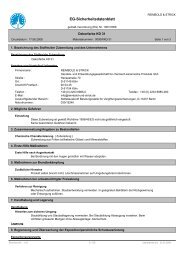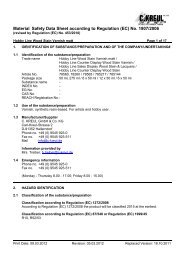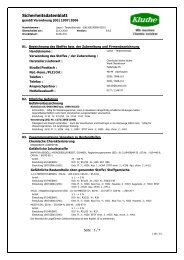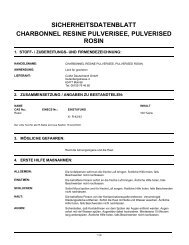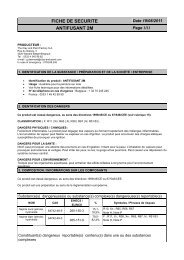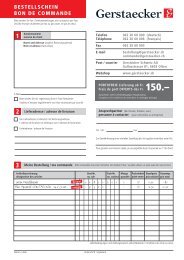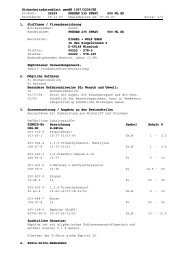Die unterstrichenen Texte entnehmen Sie bitte dem ... - Gerstaecker
Die unterstrichenen Texte entnehmen Sie bitte dem ... - Gerstaecker
Die unterstrichenen Texte entnehmen Sie bitte dem ... - Gerstaecker
Create successful ePaper yourself
Turn your PDF publications into a flip-book with our unique Google optimized e-Paper software.
56 011<br />
Artestone<br />
Atestone ist ein hochwertiges keramisches Giesspulver, das auf der Basis von Phosphaten<br />
hergestellt ist. Es eignet sich besonders gut für die Herstellung kostbarer Relief, Skulpturen und<br />
praktischer Gebrauchs-gegenstände (Vasen, Blumenübertöpfe, Griffe, Kacheln, Mosaiksteine,<br />
Schalen, Dekorplatten etc.).<br />
<strong>Die</strong> aus Artestone hergestellten Formteile zeichnen sich durch eine extrem harte und feste - auch<br />
abriebfeste Oberfläche – und Materialstruktur aus.<br />
Artestone ist zusätzlich mit Hydrophat vermischt, so das die daraus gegossenen Fertigteile nach<br />
<strong>dem</strong> vollständigen Aushärten keine Feuchtigkeit mehr aufnehmen – also resistent gegen Wasser<br />
und Feuchtigkeit sind, somit auch sehr gut für die Herstellung von Dekorationsfiguren geeignet ist,<br />
die auch im Aussenbereich aufgestellt werden können.<br />
Verarbeitungsanleitung:<br />
Artestone wird gewichtsmässig im Verhältnis 1 Teil Wasser mit 4 Teilen Artestone vermischt. Dazu wird<br />
das pulverförmige Keramikpulver in den bereits mit Wasser gefüllen Mischbecher gefüllt, das<br />
Artestonepulver dazu langsam eingestreut. Mit einem Rührholz werden beide Komponenten miteinander<br />
vermischt, so dass ein sämiger, trotz<strong>dem</strong> gut fliess- und giessfähiger Brei entsteht, der danach ca. 1 – 2<br />
Minuten vorreagieren muss, damit die, beim Vermischen des Materials eingemischten Luftblasen<br />
entweichen können. Durch die dabei entstehende Aushärtereaktion (Exothermie) erwärmt sich das<br />
Materialgemisch auf ca. 30 – 40 °C. <strong>Die</strong> Temperatur verringert sich danach sofort wieder, so dass das<br />
Formteil beim Herausnehmen aus der Form wieder Raumtemperatur hat. Danach bleibt es 1 – 2 Stunden<br />
mittelhart, also noch gut bearbeitungsfähig, so dass während dieser Zeit kleine, mechanische Korrekturen,<br />
z. B. abschaben und egalisieren des Formrandes – speziell bei Reliefs – nacharbeiten das Sockels bei<br />
Figuren – gemacht werden können.<br />
Reliefgiessen:<br />
Giessform – wahlweise aus Kunststoff, Silicon, Polyurethan, Latex, Formaform, Creaform etc. - mit Wasser<br />
ausspülen (anfeuchten) und auf einen passenden Formrahmen legen, damit sie waagerecht liegt. <strong>Die</strong><br />
Form kann dazu seitlich auch mit kleinen Holzleisten abgestützt werden. Zuerst wird nur eine kleine<br />
Menge Giessmaterial in die Form gefüllt und mit einem Pinsel darin verteilt. Dabei sollte der Pinsel alle<br />
Flächen der Form ‚durchfahren’, damit Luftblasen, die sich evt. zwischen Form und Material festgesetzt<br />
haben, beseitigt werden. Danach wird die Form vollständig mit <strong>dem</strong> restlichen Material ausgefüllt. In die<br />
obere Bildmitte, ca. 1 cm vom oberen Rand entfernt, wird ein Reliefeingiessaufhänger (Art. 56 651)<br />
eingelegt, der hinterher in <strong>dem</strong> ausgehärteten Relief die Befestigungsmöglichkeit für das Aufhängen an<br />
einem Wandhaken bietet.<br />
Figurengiessen<br />
Artestone kann auch für das Giessen vollplastischer Formkörper und Figuren verwendet werden.<br />
Giessen in Siliconformen:<br />
Beim Ausgiessen einer zwei- oder mehrteiligen Siliconform werden die Formteile zunächst mit einer<br />
dünnen Materialschicht ausgestrichen, danach zusammengebaut, in einen passenden Formkasten gelegt<br />
oder mit stabilen Gummibändern fest zusammengehalten. Danach wird die Form vollständig mit <strong>dem</strong><br />
restlichen Material befüllt und mehrmals ‚kräftig’ auf die Arbeitssfläche aufgestellt. Dabei drückt das<br />
Giessmaterial in die Formecken und –kanten und beseitigt die evt. noch darin vorhandenen Luftblasen, die<br />
an die Materialoberfläche steigen.<br />
Nach <strong>dem</strong> Aushärten des Giessmaterials wird die Form vorsichtig auseinandergebaut und der Abguss<br />
(Replikat) daraus entnommen. <strong>Die</strong> Siliconform kann anschliessend sofort wieder für die Anfertigung der
nächsten Figur verwendet werden. (Da Artestone keine aggressiven oder chemischen Inhaltsstoffe<br />
enthält, werden die Siliconformen durch dieses Material nicht angegriffen. Ein Trennmittel ist ebenfalls<br />
nicht erforderlich.<br />
Figuren in Latexformen giessen<br />
Für das Giessen von Figuren können auch Latexformen verwendet werden. Dabei müssen <strong>Sie</strong> darauf<br />
achten, dass für die Form eine passende Halterung hergestellt wird.<br />
Dazu schneiden <strong>Sie</strong> in einen zur Höhe der Form passenden Karton ein kleines rundes oder ovales Loch,<br />
und zwar genau in der Grösse des Formdurchmessers. Passen <strong>Sie</strong> die Form danach in die Öffnung im<br />
Karton ein. <strong>Die</strong> Form muss sich leicht in den Karton einhängen lassen, und zwar so, dass der am<br />
Formende angebrachte Formwulst (Formverbreiterung mit Eingiessöffnung) überall gleich weit über der<br />
Öffnung auf <strong>dem</strong> Karton aufliegt.<br />
Befüllen <strong>Sie</strong> die Form zur Hälfte mit Giessmasse. Entnehmen <strong>Sie</strong> die Form danach aus der Halterung und<br />
bearbeiten <strong>Sie</strong> diese von aussen so mit den Händen, dass sie gut durchgeknetet wird. Das sollte vor allem<br />
an den Stellen erfolgen, in denen sich Luftblasen festsetzen können, z. B. Fuss- und Nasenspitzen, Falten,<br />
spitz oder überhaupt aus der Form herausragende Formteile, z. B. einem Rüssel, Hörner etc.<br />
Hängen <strong>Sie</strong> die Form danach wieder in die Halterung ein und befüllen <strong>Sie</strong> sie mit der restlichen<br />
Giessmasse und zwar so weit, dass diese ca. 1 – 2 mm hoch in den Formenwulst hineinragt.<br />
Wichtig: befüllen <strong>Sie</strong> die Form nicht randvoll, sondern nur wie erwähnt bis zum Formenwulst. Sonst steht<br />
die fertige Figur später auf einem zu hohen Sockel, den <strong>Sie</strong> mühevoll absägen müssen. Achten <strong>Sie</strong> dabei<br />
darauf, dass die Oberfläche in der Form glatt und gerade verläuft. <strong>Sie</strong> stellt hinterher den Figurensockel<br />
dar. (Unebenheiten oder zu hohe Sockel werden abgesägt oder mit einer Feile abgeschliffen und<br />
egalisiert).<br />
<strong>Die</strong> fertig ausgehärtete Figur wird danach vorsichtig aus der Form entnommen werden. Dazu wird die<br />
Latexform von aussen mit Wasser und etwas Seife eingerieben, die Form oben am Wulst vorsichtig von<br />
der ausgehärteten Figur abgezogen, umgekrempelt und mit einem leichten Ruck langsam – ohne<br />
anzuhalten - von der Figur abgezogen. Anschliessend wird die Form mit Wasser gereinigt, wieder<br />
umgestülpt und ist danach für das Giessen der nächsten Figur wieder verwendbar.<br />
Eigene Formen aus Creaform ausgiessen<br />
Crearform ist eine Schnellabformmasse, mit der <strong>Sie</strong> beispielsweise innerhalb von einer Stunde eine<br />
perfekte Kopie Ihrer Hand anfertigen können. Nach <strong>dem</strong> Herstellen der Form – ausführliche Anleitung liegt<br />
der Creaform-Packung bei – wird diese n u r mit Artestone ausgegossen. Im Gegensatz zu einfachen<br />
Gips- oder Modellgips-Giessmassen härtet Artestone auch in extremen Situationen, z. B. in einer zu 2/3<br />
aus Wasser bestehenden – schwammartigen Form aus. <strong>Die</strong> dabei entstehenden Fertigteile geben alle<br />
Strukturen detailgetreu wider. Deshalb wird Artestone auch als Kombinationsprodukt zu dieser<br />
Schnellabformmasse empfohlen.<br />
Reinigung von Arbeitsgeräten und Händen<br />
Noch nicht ausgehärtetes Artestone kann mit Wasser mühelos von Händen, Arbeitsgeräten oder einem<br />
Pinsel entfernt werden. Bereits erhärtetes Artestone kann nur noch mechanisch beseitigt werden. Das<br />
sollte jedoch sofort nach <strong>dem</strong> Aushärten geschehen, da das Material dann noch weich und<br />
bearbeitungsfähig ist..<br />
Einfärben von Artestone<br />
<strong>Die</strong> Artestone-Giessmischung kann mit Universal-Farbkonzentrat (71 501) beliebig eingefärbt werden.<br />
Dazu wird zu der fertigen Materialmischung Universal-Farbkonzentrat zugegeben und mit eingemischt,<br />
bis der gewünschte Farbton entstanden ist. Durch diese Farbzugabe verändern sich die mechanischen<br />
Eigenschaften des ausgehärteten Formteils nicht. Neben einer einheitlichen Farbgebung ist durch das<br />
gezielte Einquirlen von zwei oder drei zuvor mit Woodstone vorgemischten Farbmassen auch ein<br />
Marmoreffekt möglich.
Marmoreffekt<br />
Für Marmoreffekte wird ein Grundfarbton, z. B. ocker in die Giessmasse eingemischt. Paralell dazu werden<br />
ein oder zwei weitere farbige Giessmassen mit anderen Farben gemischt. Nach <strong>dem</strong> Zusammenmischen<br />
der drei farblich unterschiedlichen Giessmassen, die dabei nur ganz leicht ineinandergezogen werden<br />
sollen, wird die Giessmasse in die bereitgestellte Form gefüllt, wobei der gewünschte Marmoreffekt<br />
entsteht.<br />
<strong>Die</strong>se Informaton kann nur hinweisgebend für den Marmoreffekt sein, weil sie abhängig von der jeweiligen,<br />
farbigen Giessmasse, der Farbintensität und <strong>dem</strong> Einquierlen in die Grundgiessmasse<br />
ist.<br />
Farbige Weiterbehandlung<br />
<strong>Die</strong> aus Arterstone hergestellten Formteile können mit allen Acryl-, Latex- und Lackfarben bemalt werden.<br />
Sollen die Gegenstände ein perfektes holzartiges Aussehen erhalten, werden sie mit Effektbeize (75 611),<br />
die es in den Farben .51 eiche hell, .54 nussbaum, .55 eiche rustikal und .57 mahagon gibt,<br />
nachbehandelt.<br />
<strong>Die</strong> Beize wird dazu mit einem weichen Pinsel gleichmässig auf die Gegenstände aufgetragen, so dass<br />
dabei der Eindruck einer feinen Holzmaserung entsteht. Wird ein rustikales, recht alt wirkendes<br />
Erscheinungsbild gewünscht, wird die Beize mit einem groben Pinsel aufgetragen. Dabei entsteht eine<br />
breitere und kräftiger ausgeprägte Maserung, die nach <strong>dem</strong> Trocknen wirklich alt und antik wirkt..<br />
Nach <strong>dem</strong> Trocknen wird die ‚Holzoberfläche’ mit einer weichen Bürste nachpoliert, wobei auf den<br />
Fertigteilen ein seidenmatter Glanz entsteht.<br />
Besonders effektvoll wirken ‚Holzteile’, wenn sie hinterher noch mit Effect-Patinacreme, z. B. im Farbton<br />
dunkel-braun leicht überarbeitet werden. <strong>Die</strong> auf Wachsbasis hergestellte Creme verstärkt den Holzeffekt<br />
und vollendet damit das Aussehen dieser ‚Kunstgegenstände. Effect-Patinacreme (75 602) ist in den<br />
Farben .58 dunkelbraun,<br />
.60 rotbraun, .78 schwarz, .84 gold und .99 farblos – erhältlidch.<br />
Reizvoller Porzellaneffekt<br />
<strong>Die</strong> aus Artestone hergestellten Figuren können mit einem einzigartigen Porzellaneffekt überzogen<br />
werden. Dazu werden die Formteile mit Giessmassen-Malgrundfestiger (56 801) dünn grundiert. Danach<br />
werden sie mit transparent eingefärbter Kaltglasur lasiert. Kaltglasur ist ein 2- Komponenten- material,<br />
bestehend aus Harz und Härter – (Mischung 1 : 1). Das Harz kann mit Harz-Abtönfarben eingefärbt<br />
werden.. <strong>Die</strong> transparenten Abtönfarben können untereinander beliebig vermischt werden, so dass alle<br />
gewünschten Farbeffekte entstehen.<br />
<strong>Die</strong> Figuren erhalten nach <strong>dem</strong> Aushärten der Glasur eine sehr glatte, geschlossene Oberfläche, die vergleichbar<br />
mit denen von Porzellanfiguren ist. Vorteilhaft ist dabei der transparente Auftrag, durch den die<br />
Figuren einen einzigartigen ‚Dunkel-Hell-‚Effekt’ erhalten. <strong>Die</strong> Glasur verläuft in die vertieft liegenden<br />
Stellen der Figur stärker, wirkt dort auch dunkler, was den fertigen Figuren ein einzigartiges, sehr<br />
interessantes Aussehen verleiht. (Kaltglasur-Packung 50 100 – Harz-Abtönfarben 50 116).<br />
Metallische Reliefs und Figuren<br />
<strong>Die</strong> Rohteile aus Artestone, gleich ob als Relief oder Figur, erhalten durch das Überziehen mit Metallica-<br />
Effektfinish (71 151) ein perfektes metallisches Aussehen. Dazui werden die Formteile mit einem<br />
speziellen Farbsystem behandelt, damit sie hinterher wirklich so aussehen als wären sie aus Bronce,<br />
Kupfer oder Zinn hergestellt werden.<br />
Metallica-Effektfinish ist ein 2-Komponentenlack, mit <strong>dem</strong> die Rohteile eingestrichen werden. Nach <strong>dem</strong><br />
Trocknen, was sehr schnell geht (ca. 10 Minuten), werden die ‚Metallteile’ mit der zu diesem System<br />
gehörigen Metallica-Patina (71 180 – gibt es in den Farben .32 grünspan, .55 kupferbraun, .78 schwarz)<br />
überzogen. Nach <strong>dem</strong> Auftrocknen der Patina – was ebenfalls ca. 10 – 15 Minuten dauert, wird die<br />
Oberfläche der Gegenstände mit einem weichen Tuch, das mit Patina Abbeizer (71 190) getränkt ist,
nachbehandelt. Dabei kommt es auf den Effekt an, den der Künstler erzielen will. Ausser<strong>dem</strong> ist seine<br />
Kreativität gefordert.<br />
Wird nur wenig Patina von <strong>dem</strong> Giessteil abgenommen, erhält dieses ein altes, rustikales Aussehen. Wird<br />
mehr Patina abgenommen, kommt die metallisch-glänzende Oberfläche stärker zum Vorschein und wirkt<br />
sehr modern.<br />
Bemalen der fertigen Giessteile<br />
<strong>Die</strong> gut ausgetrockneten Reliefs und Figuren aus Artesteone können mit fast allen Farben und Lasuren<br />
verziert und bemalt werden. Bei Verwendung von wasser- oder lackhaltigen Farben müssen die<br />
Gegenstände vorher mit Giessmassen-Malgrundfestiger (Art. 56 801) dünn eingestrichen werden. <strong>Die</strong><br />
feinporige Oberfläche wird dabei verschlossen, so dass die Farben nach <strong>dem</strong> Auftragen an der Oberfläche<br />
stehen bleiben und dort fest auftrocknen!<br />
Formteile für den Aussenbereich<br />
Nach <strong>dem</strong> Grundieren der Giessteile mit Giessmassen-Malgrundfestiger werden sie zuerst bemalt oder<br />
direkt mit UV-Überzugslack (Art. 70 096) allseitig eingestrichen , und zwar so, dass das gesamte Giessteil<br />
mit diesem Speziallack bedeckt ist. UV-Überzugslack schützt die durch das Bemalen aufgetragenen<br />
Farbpigmente vor <strong>dem</strong> Ausbleichen, schützt aber gleichzeitig auch die Lackoberfläche, die nicht vergilbt,<br />
so dass der Gegenstand seine originalgetreute Farbgebung für lange Zeit beibehält.<br />
Technische Daten:<br />
Farbe<br />
schneeweiss<br />
Mischungsverhältnis :<br />
4 : 1 (4 Teile Artestone und 1 Teil Wasser)<br />
1000 g Artestone ergeben 600 ml Giessmasse<br />
Berechnung des Materialbedarfs: Fassungsinhalt der Form (ml) x 1,54<br />
Ausbreitungsmass nach DIN 51 020:<br />
300 g<br />
<strong>Sie</strong>brückstand nach DIN 4188 auf <strong>Sie</strong>b 0,09 2,7 %<br />
Giesszeit (Topfzeit) bis zum Versteifungsbeginn: 8 – 10 Minuten<br />
Reaktionszeit (Abbindezeit)<br />
20 Minuten<br />
Quellung: Artstone ist expansionsgesteuert) 0,2 %<br />
Oberflächenhärte trocken<br />
315 N/mm2<br />
Druckfestigkeit trocken:<br />
75 N/mm2<br />
Biegefestigkeit trocken:<br />
über 14N/mm2<br />
Temperaturbeständigkeit trocken: kurzzeitig bis 130 °C<br />
weiss terracotta schiefergrau<br />
Abpackgrössen: Eimer 1 kg 56 011.68 56 011.60 56 011.78<br />
Eimer 5 kg 56 012.68 56 012.60 56 012.78<br />
Eimer 12 kg 56 013.60 56 013.78<br />
Sack 25 kg 56 014<br />
Weitere Giessmassen :<br />
56 001 Artelin Reliefgiessmasse<br />
56 021 Artepur Modellgips für kleine Reliefs, Anhänger, Figuren<br />
56 031 Artelight Sehr leichte Giessmasse für holz- oder papiermaschéartige Abgüsse<br />
56 081 Kersolith Hohlgiessmasse – zum hohlen Ausgiessen von Schlauchformen (Hohlformen)<br />
56 086 Kermolin Giess- und modellierfähige Keramikmasse für Skulpturen, Masken, Vasen<br />
56 091 Crealin Giess- und spachtelbare Laminatmasse für Collagen, Landschaftsmodellbau,<br />
Spachteltechniken ‚Bildgestaltung’<br />
52 061 Woodstone Giessfähige Holzgiessmasse auf Acrylbasis, vollkommen geruchlos,<br />
klebefrei, schnitzbar – wird hinterher steinhart.<br />
Sicherheitshinweise:<br />
Artestone enthält keine gefährlichen Inhaltstoffe. Beachten <strong>Sie</strong> trotz<strong>dem</strong> diese Sicherheitsempfehlungen:
Artestone kann auch von Kindern über 5 Jahren verwendet werden. Benutzung unter Aufsicht von Erwachsenen!<br />
Das Pulver nicht einatmen und verschlucken. Das breiige Materialgemisch nicht in den Abfluss<br />
schütten. Lassen <strong>Sie</strong> die Teile normal aushärten, so dass sie diese mit <strong>dem</strong> Hausmüll entsorgen können..<br />
Englische Übersetzung<br />
Artestone<br />
Artestone is a high quality ceramic casting powder, which is manufactured on the basis of phosphates. It is<br />
particularly suited to craft valuable reliefs, sculptures, and practical objects ( vases, flower pots, handles,<br />
tiles, mosaic stones, platters, etc.).<br />
Form parts made of Artestone are distinguished by their extremely hard and solid – and yet abrasionresistant<br />
surface – material structure.<br />
Hydrophate is also mixed into the Artestone, which means that the cast parts do not absorb any liquids<br />
when they are dry – in other words, they are water and moisture resistant and thus excellently suited to<br />
make decorative figures for outdoor use, as well.<br />
Instructions:<br />
Mix Artestone by weight in a ratio of 1 part water and 4 parts Artestone. Pour the water in a mixing bowl<br />
and add the ceramic powder slowly. Mix both components well with a spatula to create a smooth and<br />
pourable paste. Let this paste react for approx. 1 – 2 minutes to eliminate any air bubbles, which may have<br />
been entrapped in the material while mixing. The hardening time (exothermy) causes the material to heat<br />
up to approx. 30 – 40 C°. Then the temperature falls abruptly and the form part is at room temperature<br />
when it is removed from the mould. It remains medium-hard for 1 – 2 hours and can be shaped e.g., the<br />
form rim can be scraped, and evened out – especially on reliefs – or the base of figures.<br />
Casting reliefs:<br />
Rinse out (moisten) casting mould – made either out of plastic, silicon, polyurethane, latex, Formaform,<br />
Creaform, etc. with water and place it horizontally on a suitable form frame. If necessary, support the form<br />
with small sticks of wood to keep it in a horizontal position. Now fill a small quantity of casting material into<br />
the form and distribute it with a brush. Make sure to brush the entire interior in order to remove any air<br />
bubbles, which may have settled between the form and the material. Then fill the form completely with the<br />
remaining material. Place a relief-casting hook (Art. 56 651) in the upper center of the picture, approx. 1 cm<br />
from the top rim. You can hang the relief up later by means of this fastener.<br />
Figure casting<br />
Artestone is also suited to cast fully plastic forms and figures.<br />
Casting with silicon forms:<br />
When you cast one or multi-part silicon forms, first coat the inside of the forms with a thin layer of material<br />
before you assemble them and then place them in a suitable form-casting vessel or secure them with<br />
rubber bands. Now fill the form with the remaining material and tap it vigorously on your work area several<br />
times. This forces the casting material into all crevices and spaces in the form and also causes any air<br />
bubbles to rise to the surface.<br />
When the casting material is hard disassemble the form carefully and remove the finished replica. The<br />
silicone form is ready for the next casting immediately. (Since Artestone contains no aggressive or<br />
chemical components the silicon forms cannot get damaged. A separating agent is also not required.)<br />
How to cast figures in latex forms<br />
Figures can also be cast in latex forms. However, the form must have a suitable support.<br />
Use a carton in the height of your form and cut out a small, round or oval hole to match the size of the<br />
form’s diameter. Then fit the form into this opening in the carton. It must be easy to hang it into the carton
and the form’s bulge (widened part of form with pour holes) must rest evenly spaced over the carton’s<br />
opening.<br />
Fill the form half full with casting paste. Then remove the form from the support and knead it from the<br />
exterior with your hands. Pay special attention to areas susceptible to air bubbles such as feet, tips of<br />
noses, folds and wrinkles, pointed or generally protruding form parts such as an elephant’s trunk, horns,<br />
etc.<br />
Now place the form into the support again and fill it with the remaining casting paste so it protrudes over<br />
the form’s bulge approx. 1 – 2 mm. Important: do not fill the form to the brim but, rather, only to the form’s<br />
bulge, as previously mentioned. If not, the finished figure later stands on a too high base, which you must<br />
saw off tediously. Make certain the form’s surface is smooth and straight. It will be the figure’s base later.<br />
(Saw off or file down any unevenness or excessive height from base.<br />
Then remove the hardened figure carefully from the form. To do so, rub the outside of the latex form with<br />
water and soap, carefully roll down the form at the bead and pull it off the finished figure with a slight, quick<br />
tug. Now clean the form with water and turn it right side out again. It is ready to mould the next form.<br />
Casting forms with Creaform<br />
Creaform is a quick-forming paste, with which you can make a cast of your hand in only one hour. When<br />
the form is finished – the Creaform package contains detailed instructions - fill it o n l y with Artestone.<br />
Contrary to simple plaster or modeling plaster-casting pastes Artestone hardens under extreme conditions,<br />
as well, e.g., in a sponge-type form filled 2/3 rd with water. The pieces crafted in this manner all resemble<br />
their respective original structures in detail. Therefore we recommend Artestone as a combination product<br />
for this quick-forming paste.<br />
Cleaning tools and hands:<br />
Liquid Artestone can be removed from hands, tools, or brushes with water. Hardened Artestone can only<br />
be removed mechanically. This should be taken care of immediately after it hardens while it is still pliable.<br />
Adding color to Artestone:<br />
Artestone casting mixture can be colored with Universal Color Concentrate<br />
(71 501) in any desired color. Simply add some color concentrate to the mixed material until the desired<br />
color hue is attained. The mechanical features of the hardened form part do not change by this color<br />
additive. Along with a solitary color it is also easy to swirl in two or three colors, which you have mixed with<br />
Artestone first to attain a marbled look.<br />
Marble effect<br />
Mix a basic colour, e.g., ocher into the casting paste to achieve a marble effect. Mix one or two other<br />
coloured casting pastes with different colours at the same time. Now mix the three different coloured<br />
casting pastes together by interweaving them lightly and pour the casting paste into a mould to achieve the<br />
desired marble effect.<br />
This information only serves as an introduction to the marble effect technique because it depends on<br />
respectively coloured casting pastes, their colour intensity and the way they are blended.<br />
Further colouring<br />
Form parts made of Artestone may be painted with acrylic paints, latex, and varnishes. Effect Stain (Art. 75<br />
611) in the optional colours .51 light oak, .54 walnut, .55 rustic oak, and .57 mahogany is available to give<br />
objects a perfectly wooden appearance.<br />
Brush the stain onto the object evenly with a soft brush to create a delicate wood grain. To attain a rustic,<br />
old appearance apply the stain with a coarse brush. The grain will appear coarser and give the object an<br />
old and antique appearance when it dries.<br />
Polish the ‘wooden surface’ with a soft brush after it dries to give the finished parts a silky-matt gloss.
‘Wooden parts’ are particularly striking if they are subsequently treated with Effect Patina Cream, e.g., in<br />
the colour hue dark brown. The wax-based cream enhances the wooden effect and thereby completes this<br />
artwork’s appearance. Effect Patina Cream (Art. 75 602) is available in the following colours: .58 dark<br />
brown, .60 reddish brown, .78 black, .84 gold, and .99 colourless.<br />
Attractive China Effect<br />
Figures made of Artestone can attain a distinctive china effect. First prime the form parts with Casting<br />
Paste Paint Primer (Art. 56 801) sparingly. Then glaze them with a transparent cold glaze. Cold glaze is a<br />
2-component material and consists of resin and hardener – (mixing ratio 1 : 1). The resin can be stained<br />
with resin toners and transparent toners can be mixed at random to attain any desired colour effect.<br />
When the glaze hardens on the figures the surface is very smooth and solid and is similar to that of china<br />
figures. The transparent coat gives the figures a unique ‘dark-light-effect’. The glaze seeps deeper into a<br />
figure’s crevices, appears darker, and thus gives the finished figures a distinct, quite interesting<br />
appearance. (Cold Glaze package Art. 50 100 – Resin Toners Art. 50 116).<br />
Metallic looking reliefs and figures<br />
Rough parts made of Artestone, whether reliefs or figures, attain a perfectly metallic look if they are coated<br />
with Metallica-Effect Finish (Art. 71 151). The form parts must be treated by means of a special colour<br />
system in order for them to appear as if they were made of bronze, copper, or tin.<br />
Coat unfinished parts with Metallica-Effect Finish, which is a 2-component varnish. It dries quickly (approx.<br />
10 minutes) and the ‘metal-looking parts’ can be coated with Metallica Patina (Art. 71 180 – available in the<br />
following colours: .32 verdigris, .55 copper brown, .78 black), which is part of this system. When the patina<br />
dries – also in approx. 10 – 15 minutes – treat the surface with a soft cloth soaked in Patina Remover (Art.<br />
71 190). It now depends on the effect you wish to attain. The artist’s creative instinct is now called for.<br />
If you remove only a slight portion of the patina from the cast part it attains an old, rustic appearance. If you<br />
remove more patina the metallic-shining surface becomes more distinct and looks quite modern.<br />
Painting the finished cast parts<br />
Well-dry reliefs and figures made of Artestone can be decorated and painted with nearly all paints and<br />
varnishes. If you intend to use paints containing water or varnish you must apply a thin coat of Casting<br />
Paste Paint Primer (Art. 56 801) first. It will seal the fine-pored surface so colours do not run and will dry<br />
rapidly!<br />
Form parts for outdoors<br />
When the cast parts are primed with Casting Paste Paint Primer coat them entirely with UV-Finishing<br />
Varnish (Art. 70 096). UV Finishing Varnish protects the colour pigments in the paint from fading and<br />
simultaneously protects the surface from yellowing. Your object’s colour remains fresh for a long time.<br />
Technical data:<br />
Colour :<br />
snow white<br />
Mixing ratio:<br />
4 : 1 (4 parts Artestone and 1 part water)<br />
1000 g Artestone = 600 ml casting paste<br />
Calculating material requirement: form’s cubical contents (ml) x 1.54<br />
Propagation loss by DIN 51 020:<br />
300 g<br />
Screening refuse by DIN 4188 on screen: 0.09 2.7 %<br />
Casting time to hardening start : 8 – 10 minutes<br />
Reaction time (setting time):<br />
20 minutes<br />
Swelling: Artestone is expansion-controlled: 0.2 %<br />
Surface hardness dry:<br />
315 N/mm2<br />
Compressive strength dry:<br />
75 N/mm2<br />
Flectional strength dry:<br />
over 14 N/mm2<br />
Temperature resistance dry: temporarily up to 130 °C
white terracotta slate-grey<br />
Package sizes: Bucket 1 kg 56 011.68 56 011.60 56 011.78<br />
Bucket 5 kg 56 012.68 56 012.60 56 012.78<br />
Bucket 12 kg 56 013.60 56 013.78<br />
Sack 25 kg 56 014<br />
Further casting pastes:<br />
56 001 Artelin relief casting paste<br />
56 021 Artepur modeling plaster for small reliefs, pendants, figures<br />
56 031 Artelight very light-weight casting paste for wood or papier maché casts<br />
56 081 Kersolith hollow casting paste – to cast tubes (hollow forms)<br />
56 086 Kermolin casting and modeling ceramic paste for sculptures, masks, vases<br />
56 091 Crealin smooth laminate paste to for collages, landscape modeling, picture crafting’<br />
52 061 Woodstone wood casting paste on acrylic basis, completely odourless non-adhesive, can be<br />
carved – will be rock hard when dry.<br />
Safety precautions:<br />
Artestone is free of any dangerous components. However, please heed the following safety<br />
recommendations:<br />
Children over the age of 5 years can work with Artestone under the supervision of adults! Do not inhale or<br />
swallow the powder. Do not pour creamy mixture down drains. Let parts dry naturally and dispose with<br />
household rubbish.<br />
Französische Übersetzung<br />
Artestone<br />
Artestone est une poudre céramique de haute qualité pour masse de coulée fabriquée sur la base de<br />
phosphates. Elle se prête tout particulièrement à la réalisation de reliefs, de sculptures et d’objets de la vie<br />
quotidienne (pots, vases, poignées, faïences, pierres de mosaïques, boles, carreaux de décoration, etc.).<br />
Les moules fabriqués en Artestone sont durs et résistants, surtout contre toute usure par frottement.<br />
En plus, de l’Hydrophate est mélangé à Artestone ce qui empêche que les objets terminés absorbent<br />
l’humidité. Ils peuvent être ainsi parfaitement installés à l’extérieur.<br />
Mode d’utilisation<br />
Artestone est mélangé dans un rapport de 1 à 4 avec de l’eau. Pour ce faire, vous versez doucement la<br />
poudre d’Artestone dans le récipient de malaxage contenant l’eau. Remuez avec une spatule les deux<br />
composants, obtenant ainsi une bouillie<br />
consistante, mais néanmoins fluide et coulante que vous devez laissez agir pendant 1 à 2 minutes, afin<br />
que les bulles d’air incluses au moment du mélange puissent s’échapper. Par l’exothermie qui se produit à<br />
ce moment, la masse de coulée s’échauffe à env. 30 à 40 °C. La température baissera immédiatement par<br />
la suite de nouveau, de sorte que l’objet coulé aura la température ambiante au moment du démoulage.<br />
Pendant 1 à 2 heures celui-ci restera encore bien maniable. Il sera alors possible d’y apporter<br />
mécaniquement certaines petites corrections, comme p. ex. racler et égaliser les bords, surtout pour les<br />
reliefs, ou retravailler les socles pour les figurines.<br />
Moulage de reliefs<br />
Rincez à l’eau le moule fait en caoutchouc, silicone, polyuréthane, Latex, Formaform, ou Créaform, etc.<br />
pour le mouiller et posez le sur un cadre correspondant pour le mettre en position horizontale. Il est<br />
également possible de supporter le moule latéralement par de petits listeaux en bois. Versez d’abord une<br />
peitite quantité du mélange dans le moule et repartissez le bien avec un pinceau. Veillez à ce que toute la<br />
surface soit touchée par le pinceau, afin que les bulles d’air qui ont pu se former entre la paroi du moule et
la masse de coulée s’échappent. Puis, remplissez complètement le moule avec le reste du mélange. Au<br />
centre de la partie supérieure de l’image, à 1 cm environ du bord, introduisez un crochet (art. 56 651) qui<br />
permettra plus tard d’accrocher le relief au mur.<br />
Moulage de figurines<br />
Artestone peut également être utilisé pour le moulage d’objets et de figurines plastiques.<br />
Moulage dans des moules de silicone<br />
En utilisant un moule en silicone de deux ou de plusieurs parties, les parois seront d’abord recouvertes<br />
d’une fine couche de produit, assemblées, puis posées dans une caisse de montage assortie qui sera<br />
retenue par des bandes de caoutchouc. C’est seulement alors que le moule sera complètement rempli<br />
avec le reste de la masse de coulée. Frappez plusieurs fois le moule avec force contre la table pour faire<br />
descendre le matériel et pour faire sortir les bulles d’air qui monteront à la surface.<br />
Une fois la masse de coulée séchée, démontez avec précaution le moule pour faire sortir la replique que<br />
vous venez d’achever. Le moule peut immédiatement être réutilisé. Vu qu’Artestone ne contient aucun<br />
composant chimique ou agressif, les moules ne seront pas attaqués par son utilisation. Il n’est non plus<br />
nécessaire d’appliquer un agent de séparation.<br />
Moulage dans des moules de Latex<br />
Il est également possible d’utiliser des moules en Latex. Dans ce cas, il est absolument nécessaire de<br />
prévoir une fixation adéquate pour le moule.<br />
Pour réaliser celle-ci, vous découpez dans un carton ayant la hauteur du moule, une ouverture ronde ou<br />
ovale. Le moule doit pouvoir s’accrocher facilement dedans et il est important que le bord de l’ouverture<br />
du moule repose à équidistance sur tout le rebord de l’ouverture du support.<br />
Remplissez le moule à moitié avec de la masse de coulée, puis sortez le moule de son support. Pétrissez<br />
l’ensemble avec les doigts de l’extérieur. Ceci est surtout important aux endroits où des bulles d’air ont pu<br />
se former, tels que points des pieds, point du nez, rides, et tous les endroits dépassant le moule dans une<br />
direction ou dans une autre, comme p. ex. la trompe d’un éléphant, des cornes, etc.<br />
Remettez alors le moule dans son support et remplissez le complètement avec le reste de la masse de<br />
coulée de sorte qu’elle monte de 1 à 2 mm env. dans le bourrelet du moule. Ne pas le remplir à ras, car<br />
ceci provoquerait que la figurine soit placée sur un socle trop élevé. Vous seriez alors obligé à le scier<br />
péniblement. Veillez à ce que la surface du socle soit plate et à niveau. Toutes les irrégularités doivent être<br />
ou sciées ou limées.<br />
L’objet complètement séché peut alors être sorti du moule. Pour ce faire, vous mouillez de l’extérieur le<br />
moule en Latex avec de l’eau et un peu de savon, en tirant avec précaution du haut du bourrelet vers en<br />
bas. Le moule ainsi rabattu retirez le lentement du repliquat, d’un seul coup, avec un léger coup. Le moule<br />
est alors rincé et retourné, ainsi prêt pour la prochaine utilisation.<br />
Faites vos propres moules de Creaform<br />
Creaform est une masse de coulée pour moulage rapide vous permettant p. ex. de recopier votre main en<br />
une heure. Une fois que le moule est confectionné – des instructions détaillées sont jointes – il sera utilisé<br />
pour refaire la copie de votre main en utilisant uniquement Artestone. Contrairement aux autres produits<br />
en plâtre ou plâtre de modelage, Artestone sèche même dans des moules spongeux consistant en 2/3<br />
d’eau. Toutes les parties moulées sont recopiées exactement dans toutes leurs structures. C’est la raison<br />
pour laquelle il est conseillé d’utilisé Artestone en combinaison avec cette masse de coulée rapide.<br />
Nettoyage des mains et des outils<br />
Le produit non-durci peut être enlevé à l’eau des mains, des outils ou d’un pinceau. Le produit durci ne<br />
peut être enlevé que mécaniquement. Il est, cependant, préférable de l’ôter tant que le produit est encore<br />
assez moux
Coloration de Artestone<br />
Artestone peut être coloré à volonté avec des concentrés de coloris universels (71 501). Le coloris sera<br />
rajouté au mélange préparé jusqu’à ce que vous obteniez la coloration désirée. Les qualités mécaniques<br />
ne changent pas par l’adjonction de ces coloris. Pour obtenir un effet marbré, vous devez rajouter à la<br />
masse principale préparée, de petites quantités de masse de coulée colorées à part, ce qui vous donnera<br />
cet effet spécial.<br />
Cette information est de caractère général, vu que la coloration dépendra de la qualité de la masse de<br />
coulée et de son coloris initial.<br />
Finition à la couleur<br />
Toutes les pièces fabriquées en Artestone peuvent être peintes avec des peintures acryliques, de Latex ou<br />
de la laque. Si vous désirez leur donner un aspect de bois, couvrez les d’un mordant d’effets (75 611) qui<br />
existe dans les coloris chêne clair 51, noix 54, chêne rustique 55 et acajou 57.<br />
Le mordant sera appliqué régulièrement avec un pinceau souple pour obtenir un effet de madrure. Si vous<br />
désirez obtenir un effet plutôt rustique, utilisez un gros pinceau. Ceci donnera une madrure plus grossière<br />
qui, une fois séchée, aura vraiment l’aspect antiquise.<br />
Après séchage, frottez avec un torchon souple pour donner à la surface un aspect mat et soyeux.<br />
Vous pouvez encore augmenter l’effet en traitant la pièce à la fin avec une crème de patine, p. ex. dans le<br />
coloris marron foncé. Cette crème (réf. 75 602), fabriquée à base de cire, augmente l’effet de bois et<br />
perfectionne l’aspect dans l’ensemble. Elle existe dans les coloris marron foncé 58, marron roux 60, noir<br />
78, or 84 et incolore 99.<br />
Effet de porcelaine<br />
Aux objets fabriqués en Artestone vous pouvez également donner un effet spécial de porcelaine. Pour la<br />
réalisation, couvrez l’objet d’une couche mince d’apprêt (56 801). Puis, il sera recouvert d’une glaçure à<br />
froid. La glaçure à froid est un produit à deux composants composé de la résine et du durcisseur (rapport<br />
de mélange 1 : 1). La résine peut être coloriée avec un colorant transparent. Ces colorants se laissent<br />
mélanger enre eux, de sorte que toutes les combinaisons de couleurs sont possibles.<br />
Une fois la glaçure durcie, la surface devient lisse et uniforme pareille à la surface d’un objet en porcelaine.<br />
La couche transparente, donne à l’objet un effet de « sombre-claire ». La glaçure s’écoule dans les coins<br />
ou dans les endroits plus bas que les autres et donne l’aspect plus sombre, produisant un effet très<br />
intéressant (paquet de glaçure à froid 50 100 – coloris pour résine 50 116).<br />
Reliefs métalliques et figurines<br />
Les pièces brutes en Artestone, que ce soient des reliefs ou des figurines, obtiennent un aspect métallique<br />
parfait, si vous les couvrez avec Metallica-Effektfinish (71 151). Pour obtenir cet effet, les pièces seront<br />
traitées avec une méthode de coloration spéciale, donnant à la fin l’impression qu’elles sont effectivement<br />
en bronze, cuivre ou étain.<br />
Metallica-Effektfinish est une laque à deux composants dont vous couvrez les objets à traiter. Après<br />
séchange (10 minutes environ), ils seront par ailleurs re- couverts avec Metallica-Patina (71 180), qui<br />
est existe dans les coloris vert-de-gris 32, marron cuivre 55, noir 78. Une fois que cette patine a également<br />
séché – ce qui dure entre 10 à 15 minutes, les objets seront frottés avec un torchon souple, imbibé de<br />
Patina-Abbeizer (décapant) 71 190. Ainsi, et suivant votre imagination, vous obtiendrez l’effet désiré. Si<br />
vous n’enlevez que peu de la patine, l’objet aura l’aspect ancien, si vous en enlevez plus, l’objet deviendra<br />
brillant et aura l’aspect plus moderne.<br />
Peindre les objets terminés<br />
Les reliefs et figurines bien séchés peuvent être décorés et peints avec presque toutes les peintures et<br />
glaçures. Dans le cas d’utilisation de peintures contenant de l’eau ou de la laque, ils doivent être<br />
recouverts d’une mince couche d’apprêt (art. 56 801). Ainsi, les pores fins seront bouchés, et les peintures<br />
resteront à la surface où elles sècheront.
Pièces pour l’extérieur<br />
Après avoir couverts les objets avec une couche de fond, toutes les parties seront d’abord repeintes ou<br />
recouvertes d’une laque UV (article 70 096). La laque UV protège les pigments d’un blanchissement, et<br />
protège également la surface d’un jaunissement, afin que les objets gardent leur coloris d’origine le plus<br />
longtemps.<br />
Données techniques :<br />
Couleur<br />
blanc de neige<br />
Rapport de mélange<br />
4 : 1 (4 parts d’Artetone et 1 part d’eau)<br />
1000 gr. Artestone donne 600 ml de masse de coulée<br />
Calcul du matériel nécessaire volume du moule (ml) x 1,54<br />
Détente selon DIN 51 020<br />
300 gr.<br />
Crible selon DIN 4188 0,09 2,7 %<br />
Durée de fluidité<br />
8 à 10 minutes<br />
Durée de la prise<br />
20 minutes<br />
Gonflement 0,2 %<br />
Duretée de la surface à l’état sec 315 N/mm2<br />
Résistance à la pression à l’état sec 75 N/mm2<br />
Résistance à la pliure à l’état sec au-dessus de 14 N/mm2<br />
Résistance à la température à l’état sec pour une courte durée 130 °C<br />
Emballages : blanc terra-cotta gris ardoise<br />
Sceau de 1 kg 56 011,68 56 011.60 56 011.78<br />
Sceau de 5 kg 56 012.68 56 012.60 56 012.78<br />
Sceau de 12 kg 56 013.60 56 013.78<br />
sac de 25 kg 56 014<br />
D’autres masses de coulée :<br />
56 001 Artelin<br />
56 021 Plâtre de modellage pour petits reliefs, pendentifs, figurines<br />
56 031 masse de coulée très légère pour moulage de bois ou de papier mâché<br />
56 081 Kersolith pour moulage creux en boudin<br />
56 086 Kermolin masse de céramique modelable pour sculptures, masques, etc.<br />
56 091 Crealin masse de laminée moulable, masticable pour collages, construction de modèles de<br />
paysages, techniques de masticage ‘images’<br />
52 061 Woodstone masse de coulée de bois à base acrylique, entièrement sans odeur, ne colle pas, se<br />
laisse couper, devient dur comme de la pièrre.<br />
Instructions de sécurité<br />
Artestone ne contient aucun produit nocif. Nous vous recommandons, néanmoins, d’observer les<br />
instructions suivantes : Utilisable par des enfants de plus de 5 ans, sous la surveillance d’un adulte. Ne pas<br />
aspirer et ne pas avaler la poudre. Ne pas jetter le produit dans l’égout. Laisser sécher normalement, puis<br />
jetter le surplus aux ordures ménagères.
Italienische Übersetzung<br />
ARTESTONE<br />
Artestone è una polvere ceramica pregiata, prodotta sulla base di fosfati. È idonea in particolare per la<br />
realizzazione di rilievi pregiati, sculture e oggetti d’uso pratici (vasi, vasi da fiori, manici, piastrelle, pietrine<br />
di mosaico, ciotole, lastre decorative etc.)<br />
I pezzi prodotti con Artestone si distinguono per una superficie (antistriscio) e struttura del materiale molto<br />
dura e resistente.<br />
Artestone è mescolata inoltre con una sostanza idrorepellente (Hxdrophat), in modo che gli oggetti ottenuti<br />
con questo prodotto, una volta perfettamente induriti, non assorbono più umidità. Artestone, essendo<br />
resistente sia all’acqua che all’umidità. è adatta anche per figure decorative per l’ambito esterno.<br />
Istruzioni di lavorazione:<br />
Artestone viene mescolata a peso secondo il rapporto di 1 parte di acqua e 4 parti di Artestone. La polvere<br />
ceramica viene versata lentamente nel recipiente di miscelazione già contenente l’acqua e mescolata con<br />
un mescolino fino ad ottenere un composto denso ma fluido idoneo ad essere versato nella forma. È<br />
necessario lasciar poi reagire il composto permettendo ad eventuali bolle di salire in superficie. Mediante la<br />
reazione esotermica che ne deriva, il composto si riscalda fino a ca. 30-40 ° C. La temperatura in seguito<br />
si riduce e quando la figura viene estratta dallo stampo avrà di nuovo la temperatura ambiente. Questa<br />
resta poi per 1-2 ore di media durezza, ovvero ancora lavorabile. In questo lasso di tempo si possono<br />
apportare piccole correzioni meccaniche, come raschiare e livellare il contorno –specie nei rilievi- o rifinire<br />
lo zoccolo nelle figure.<br />
Modellatura di rilievi:<br />
Lo stampo – a scelta di materiale sintetico, silicone, poliuretano, lattice, Formaform, Creaform etc. – va<br />
sciacquato con acqua (inumidito) e posto su un adeguata staffa in senso orizzontale. lo stampo può essere<br />
eventualmente sostenuto lateralmente con pezzetti di legno. Versare dapprima solo una piccola quantità di<br />
composto nello stampo e distribuirla con un pennello. Passarne accuratamente col pennello tutte le<br />
superfici in modo da evitare il formarsi di bolle d’aria o eliminare quelle già esistenti. Riempire quindi lo<br />
stampo col restante composto. Nella parte mediana superiore, a ca. 1 cm dal bordo superiore viene<br />
sistemato un gancio a occhiello (Art. 56 651), che successivamente darà la possibilità di appendere il<br />
rilievo indurito ad un gancio della parete.<br />
Modellatura di figure:<br />
Artestone può essere usata anche per modellare figure a tutto tondo.<br />
Modellare in stampi di silicone:<br />
Nel riempire stampi in silicone costituiti da una, due o più parti, queste vengono dapprima spennellate con<br />
un sottile strato di materiale, poi riunite insieme, poste in una staffa adeguata oppure fissate bene insieme<br />
con elastici solidi. Lo stampo viene poi riempito completamente con il composto e scosso più volte contro<br />
la superficie di lavoro in modo che il composto penetri bene in ogni angolo dello stampo, eliminando nel<br />
contempo eventuali bolle d’aria che salgono così in superficie.<br />
Una volta che il composto versato è asciutto, le parti dello stampo vengono smontate con precauzione<br />
estraendovi il modello. Lo stampo di silicone può venire subito riutilizzato per ultimare la figura successiva.<br />
(Poiché Artestone non contiene sostanze aggressive o chimiche, gli stampi in silicone non ne vengono<br />
danneggiati. Anche l’applicazione di una sostanza isolante per rimuovere la figura dallo stampo, è<br />
superflua.<br />
Modellare figure in stampi di lattice<br />
Per modellare figure si possono usare anche stampi (forme) in lattice. In tal caso dovete preparare per lo<br />
stampo un apposito sostegno.<br />
Tagliate un piccolo foro rotondo o ovale in un cartone conforme all’altezza dello stampo, esattamente nella<br />
misura del suo diametro. Inserite poi lo stampo nell’apertura. Lo stampo deve rimanere leggermente
sospeso nel cartone e cioè in modo che il rigonfiamento (l’allargamento dello stampo con l’apertura per la<br />
colata) risulti ovunque equidistante sull’apertura del cartone.<br />
Riempite lo stampo a metà con il composto. Estraete poi lo stampo dal sostegno e lavorate il composto<br />
con le mani dall’esterno in modo che lo stampo ne venga ben impastato. Questo vale soprattutto per i<br />
punti, nei quali potrebbero formarsi bolle d’aria., ad esempio le punte dei piedi o del naso, le pieghe o le<br />
parti sporgenti della figura, ad es. una proboscide, le corna etc.<br />
Riponete quindi lo stampo nuovamente nel foro di sospensione e riempitelo con il resto del composto fino a<br />
1—2 mm oltre il rigonfiamento esterno.<br />
Importante: non riempite lo stampo fino all’orlo, bensì come detto solo fino al suo rigonfiamento. Altrimenti<br />
la figura ultimata risulterà avere uno zoccolo troppo alto che dovrete faticosamente segare. Fate attenzione<br />
che la superficie dello stampo sia liscia e uniforme poiché questa costituisce poi lo zoccolo della figura.<br />
(Dislivelli o zoccoli troppo alti vengono eventualmente segati o livellati).<br />
La figura finita e indurita viene poi estratta dallo stampo. Lo stampo in lattice viene a questo scopo sfregato<br />
con acqua e un po’ di sapone dall’esterno, sopra sul rigonfiamento viene con precauzione sfilato dalla<br />
figura, rivoltato e con una leggera scossa –senza indugiare- separato lentamente dalla figura. Lo stampo<br />
va poi lavato con acqua, di nuovo rivoltato ed è pronto per colarvi la figura successiva.<br />
Creare da sé stampi di Creaform<br />
Creaform è un prodotto che si può modellare rapidamente e col quale voi potete, ad esempio, ottenere in<br />
un’ora una perfetta copia della vostra mano. Dopo aver realizzato lo stampo –ampie istruzioni si trovano<br />
nella confezione- questo viene riempito con Artestone. A differenza di prodotti per modellare di gesso,<br />
Artestone indurisce anche in condizioni estreme., ad esempio in uno stampo spugnoso costituito di 2/3<br />
d’acqua. I pezzi cosi ricavati riproducono tutte le strutture perfettamente. Per questo Artestone viene<br />
consigliato anche in combinazione con questa pasta a modellatura rapida.<br />
Pulizia degli arnesi da lavoro e delle mani<br />
Artestone non ancora indurita può essere eliminata senza problemi con acqua sia dalle mani che dagli<br />
arnesi di lavoro e dal pennello. Nel caso sia già indurita bisogna asportarla meccanicamente, e ciò deve<br />
avvenire comunque dopo la prima fase di indurimento, quando il materiale è ancora malleabile.<br />
Colorazione di Artestone<br />
Il composto di Artestone si può colorare a piacere con Universal-Concentrato (71 501). Basta aggiungere<br />
al materiale pronto per la colata il concentrato di colore Universal e mescolarlo fino ad ottenere la tonalità<br />
di colore desiderata. L’aggiunta del colore non modifica le qualità meccaniche del stampo ultimato e<br />
indurito. Si possono ottenere anche effetti marmorei aggiungendo due o tre colori precedentemente<br />
mescolati.<br />
Effetti marmorei<br />
Per ottenere effetti marmorei viene mescolata una tonalità di colore base, ad esempio ocra, nel composto<br />
per la colata. Nel contempo vengono mescolati uno o due ulteriori composti colorati con altri colori. Dopo<br />
aver mescolato i tre diversi composti, che vanno impastati tra loro con cura, la massa così ottenuta viene<br />
versata nello stampo, ottenendo così l’effetto marmoreo desiderato.<br />
Questa informazione è puramente indicativa, poiché l’effetto finale dipende dalle singole paste colorate,<br />
dall’intensità dei colori usati e dalla loro miscelazione nel composto di base.<br />
Ulteriore colorazione<br />
I pezzi ottenuti con Artestone si possono trattare con tutti i colori acrilici, latice e tutte le vernici. Se gli<br />
oggetti devono presentare un aspetto ligneo, vengono trattati con le apposite tinture (75 611), che esistono<br />
nei colori 51 quercia chiaro, 54 noce, 55 quercia rustica, 57 mogano.<br />
La tintura viene applicata in modo uniforme con un pennello morbido in modo che ne risulta un effetto di<br />
venature lignee. Se si desidera ottenere un effetto rustico invecchiato, basta applicare la tintura con un
pennello ruvido. Le venature risulteranno così più accentuate e l’oggetto apparirà veramente vecchio e<br />
antico.<br />
Una volta asciutta, la ‘superficie lignea’ viene strofinata con un panno morbido e gli oggetti presenteranno<br />
una brillantezza serica opaca.<br />
Di particolare effetto appaiono i ‘pezzi lignei’ se alla fine verranno ancora passati con la Patina speciale, ad<br />
esempio nel tono marron scuro. Questa crema ottenuta su una base di cera accentua l’effetto legno, dando<br />
un tocco finale a questi ‘oggetti artistici’. Effect-Patinacreme (75 602) è disponibile nei colori 58 marron<br />
scuro, 60 marron rosso., 78 nero, 84 oro e 99 neutro.<br />
Affascinante effetto porcellana<br />
Le figure realizzate con Artestone possono venire rifinite con un particolare effetto porcellana. Dare<br />
dapprima una sottile mano di fondo ai pezzi col fissatore per prodotti da modellatura (56 801). verniciarli<br />
quindi con la vernice a freddo colorata trasparente. La vernice a freddo è un materiale a due componenti,<br />
resina e indurente - (in rapporto 1 : 1). La resina si può colorare con colori per resine digradanti... I colori<br />
trasparenti digradanti si possono mescolare tra loro a piacere, in modo da ottenere tutti gli effetti di colore<br />
desiderati.<br />
Le figure, una volta che la vernice è asciutta, presentano una superficie molto liscia e compatta,<br />
paragonabile a quella degli oggetti in porcellana. Di vantaggio è la rifinitura trasparente che conferisce alle<br />
figure uno straordinario effetto chiaro-scuro. La vernice risultando più densa e scura nelle pieghe o nelle<br />
profondità dell’oggetto, accentua l’aspetto assai interessante di questi oggetti così rifiniti. (Confezione di<br />
vernice a freddo 50 100 – Colori digradanti alla resina 50 116).<br />
Rilievi e figure con effetti metallici<br />
Le parti finite realizzate con Artestone e ancora grezze, sia rilievi che figure, presenteranno un effetto<br />
perfettamente metallico se rifiniti con Metallica-Effektfinish (71 151). I pezzi vengono in tal caso trattati con<br />
uno speciale sistema di colorazione e risulteranno infine come se fossero realmente di bronzo, di rame o<br />
di zinco.<br />
Metallica-Effektfinish è una vernice a due componenti, con la quale i pezzi grezzi vengono spennellati.<br />
Dopo che la vernice è asciutta (ca. 10 minuti), i pezzi di ‘metallo’ vengono passati con la Patina-Metallica<br />
(71 180) che è parte di questo programma ed esiste nei colori .32 verde rame, .55 marron rame, .78. nero.<br />
Quando la Patina è asciutta –ca. 10—15 minuti) la superficie degli oggetti così trattati vengono strofinati<br />
con un panno imbevuto con Patina acida (71 190). Dipende dall’effetto che l’artista desidera ottenere e la<br />
sua creatività viene qui stimolata. Se viene tolta solo poca Patina dall’oggetto, questo presenta un aspetto<br />
vecchio e rustico. Se ne viene eliminata di più prevale invece sulla superficie l’effetto di lucentezza<br />
metallica.<br />
Colorazione di pezzi finiti<br />
Rilievi e figure ben asciutti prodotti con Artestone, possono essere dipinti e decorati con quasi tutti i colori<br />
e le vernici. Se si usano colori ad acqua o contenenti vernici, gli oggetti vano prima spennellati con un<br />
sottile strato di fissatore per prodotti da modellatura (Malgrundfestigerr Art. 56 801). La superficie porosa<br />
viene impermeabilizzata, in modo che i colori non sfumano e asciugano perfettamente.<br />
Pezzi creati per l’ambito esterno<br />
Dopo aver dato una mano di fondo col fissatore, i pezzi modellati vengono dapprima colorati o trattati<br />
direttamente con UV-Vernice da rivestimento (Art. 70 096) avendo cura di passarla bene in ogni parte<br />
dell’oggetto. Questa vernice protegge i pigmenti di colore e impedisce che sbiadiscano o, se vernici, che<br />
ingialliscano.<br />
Dati tecnici:<br />
Colore<br />
bianco neve<br />
Composizione:<br />
4 : 1 (4 parti di Artestone e 1 parte di acqua)<br />
Calcolo del materiale necessario: Contenuto di capienza dello stampo (ml) x 1,54
Grado di spiegamento DIN 51 020<br />
300 g<br />
Residuo di setacciatura Tempo di colata 0,09 2,7 %<br />
Tempo di colata fino all’inizio di solidificazione 8 – 10 minuti<br />
Tempo di reazione (tempo di presa)<br />
20 minuti<br />
Gonfiamento: Artestone è a espansione pilotata 0,2 %<br />
Durezza superficie asciutta<br />
315 N/mm²<br />
Resistenza di compressione asciutto<br />
75 N/mm²<br />
Resistenza di flessione asciutto<br />
oltre 14N/mm²<br />
Resistenza alla temperatura asiutto a breve termine fino a 130°<br />
bianco terracotta grigio ardesia<br />
Confezioni: Secchio 1 kg 56 011.68 56 011.60 56 011.78<br />
Secchio 5 kg 56 012.68 56 012.60 56 012.78<br />
Secchio 12 kg 56 013.60 56 013.78<br />
Sacco 25 kg 56 014<br />
Ulteriori prodotti da modellatura<br />
56 001 Artelin massa da colata per rilievi<br />
56 021 Artepur gesso per modellatura di piccoli rilievi, pendenti, figurine<br />
56 031 Artelight massa molto leggera per colate simillegno o cartapesta<br />
56 081 Kersolith massa da colata per oggetti concavi e tubolari<br />
56 086 Kemolin massa ceramica per colata e modellatura di sculture, maschere, vasi<br />
56 091 Crealin massa di laminato da colata e da spatola per collage, modellismo paesaggistico,<br />
tecnica della pittura a spatola<br />
56 061 Woodstone massa da colata lignea su base acrilica, inodore, senza colle, si può intagliare –<br />
diventa dura come pietra.<br />
Precauzioni:<br />
Artestone non contiene sostanze pericolose. Nondimeno osservate attentamente queste norme di<br />
sicurezza: Artestone può essere usata anche da bambini sotto i cinque amni, purché sotto la sorveglianza<br />
di adulti. Non inalare o ingoiare la polvere. Non versare il composto nell’acquaio. Lasciare indurire le parti<br />
di materiale e smaltirle con gli usuali rifiuti.


